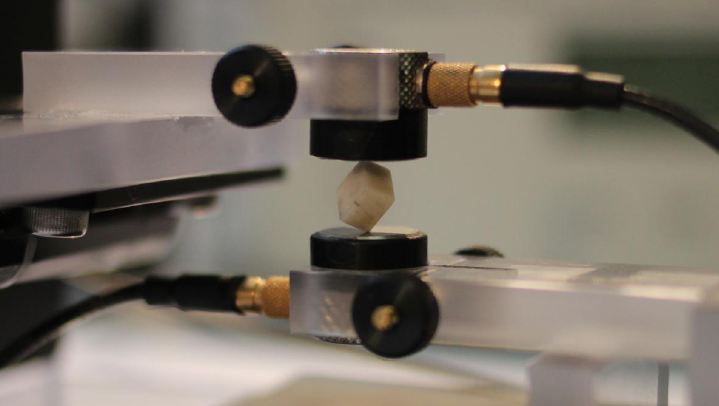Resonant Ultrasound Spectroscopy (RUS)

One RUS setup at the Laboratoire d'Imagerie Biomédicale
Working principle
RUS is a vibrational technique which is convenient to measure the anisotropic stiffness tensor of small specimens. The "modern" RUS methodology was established in the 1990's to measure small specimens (characteristic size of a few millimeters) of low damping materials such as metals.
We developed a setup and signal processing methods dedicated to the RUS measurement of attenuative materials such as cortical bone and polymeric materials. Briefly, a rectangular parallelepiped (or cylindrical) specimen is placed with slight contact between a pair of shear ultrasonic transducers (V154RM, Panametrics, Waltham, MA), one acting as an emitter and the second one as a receiver. The frequency response is recorded using a vectorial network analyzer (Bode 100, Omicron Electronics GmbH, Klaus, Austria) and a broadband charge amplifier (HQA-15 M-10 T, Femto Messtechnik GmbH, Berlin, Germany). The frequency band of analysis is usually tuned for each specimen so as to contain at least 20 to 30 of the first mechanical resonant frequencies of the specimen.
In RUS, the elastic properties of the specimen are estimated by solving an inverse problem which consists of the comparison of the measured resonant frequencies to model-predicted frequencies. The model is that of a vibrating elastic specimen with stress-free boundary conditions. For rectangular parallelepiped or cylindrical specimens resonant frequencies are efficiently obtained with the Rayleigh-Ritz method. The geometry, mass density and stiffness of the specimen entirely determine the frequencies, so that the stiffness can be adjusted until the best match between the model and the experiment has been reached. This is usually done thought the minimization of a quadratic objective function. An issue is to achieve a correct pairing of the measured frequencies to their calculated counterparts. If the initial guess is far form the actual elasticity and if the predicted resonant modes are not all observed experimentally, as it is the case for high damping materials such as bone, the correct pairing is difficult to obtain. We have introduced a Bayesian formulation of the inverse problem that automatically solves the joint problem of finding the correct pairing of frequencies and estimating the elastic properties . The Bayesian formulation was validated by comparing determined elastic coefficients for several characteristic specimens with the traditionnal formulation.
Related publications of our group
- Bernard S, Schneider J, Varga P, Laugier P, Raum K, Grimal Q. Elasticity-density and viscoelasticity-density relationships at the tibia mid-diaphysis assessed from resonant ultrasound spectroscopy measurements. Biomech Model Mechanobiol. 2015
- S Bernard, G Marrelec, P Laugier, Q Grimal Bayesian normal modes identification and estimation of elastic coefficients in resonant ultrasound spectroscopy. Inverse Problems, 2015
- Bernard, S. ; Grimal, Q. ; Laugier, P. Resonant ultrasound spectroscopy for viscoelastic characterization of anisotropic attenuative solid materials. J. Acoust. Soc. Am. 135 : 2601-2613, 2014.
- S Bernard, Q. Grimal and P Laugier. Accurate measurement of cortical bone elasticity tensor with resonant ultrasound spectroscopy. Journal of the Mechanical Behavior of Biomedical Materials, 18, P. 12-19, 2013.
Software
A suite of computer programs to process raw RUS signals to determine automatically the stiffness tensor of materials is being developed. More information on demand.Some links to information on RUS
- Joseph R. Gladden webpage
- GREMAN laboratory webpage
- Colorado state university
- The reference book: ``Resonant Ultrasound Spectroscopy: Applications to Physics, Materials Measurements, and Nondestructive Evaluation'', 1997 Albert Migliori and John L. Sarrao. Wiley, New York